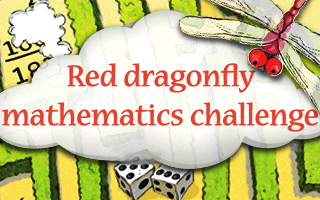Many of the questions students encounter in day-to-day mathematics lessons do not provide a sense of what it is like to engage in mathematical thinking. Indeed, some students see mathematics as being only about finding the correct answers to large quantities of questions that are not particularly challenging. This lack of challenge has led to the recommendation that … greater emphasis be given to providing students with frequent exposure to higher-level mathematical problems rather than routine procedural tasks, … with increased opportunities for students to discuss alternative solutions and explain their thinking. (p. xii) Australian National Numeracy Review Report (2008)
Developing students’ mathematical reasoning relies upon having access to tasks that are easily understood and promote thinking. Yet where do you find challenging mathematical problems suitable for primary mathematics lessons? This publication has been developed to help to address this need.
The Red dragonfly mathematics challenge is an English adaptation of a classic Japanese mathematics problem-solving book, known as the Math Brain Quiz (Red) or more commonly as the Red book, by Mr Yasuhiro Hosomizu. The Red dragonfly mathematics challenge offers many open-ended problems that can be challenging to students and teachers alike. Mr Hosomizu’s Red book has until recently only been available in Japanese and his generosity in sharing with other teachers and students is gratefully acknowledged. This adaptation of the Japanese publication has been made possible through the efforts of Professor Masami Isoda, Dr Maitree Inprasitha, Khon Kaen University, Thailand, Mr. Peter Suranyi, CRICED, University of Tsukuba and Dr Peter Gould.
Some of the problems may be familiar to those with a strong interest in developing mathematical problem solving proficiency, while many will be new or provide a fresh presentation of a familiar idea.
For the teacher, this book aims to develop an appreciation of:
- The design of mathematics problems that develop mathematical reasoning in young students. The problems emphasise determining patterns, and the conditions under which the patterns arise. This in turn can encourage students to explain the reasoning underpinning general mathematical relationships.
- The value of specific methods of reasoning in the problem solving processes. These methods of reasoning are part of mathematics and can strengthen students’ mathematical dispositions to investigate mathematical challenges.
For the student and interested parents, the Red dragonfly mathematics challenge provides a range of problems to challenge and stimulate interest and to reward perseverance. Moreover, the challenges emphasise essential algebraic reasoning.
This publication has been developed to be accessible to a wide range of people, from primary school students to pre-service teachers and parents. All the challenges in this book have been used in primary classrooms. Every now and then, the solutions include unusual and interesting approaches that can widen the reader’s ways of thinking.
















































